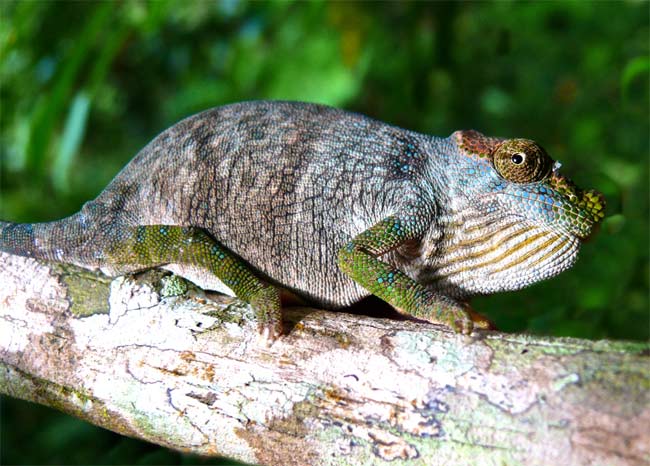Teensy Chameleon Is New Species

A tiny chameleon species with a scaly horn atop its snout and blue dots on its limbs has been discovered in Tanzanian forests.
"It would sit quite easily on one finger," said Andrew Marshall of the University of York and Flamingo Land, adding the chameleon's body spans just 2.8 inches (about 72 mm) with a tail of nearly equal length.
Marshall first spotted the animal, now called Kinyongia magomberae, while surveying monkeys in the Magombera forest. He disturbed a twig snake that had been eating one of the chameleons. Once startled, the snake dropped its already dead prey.
So far, four specimens of the species have been observed in Tanzania's Magombera forest, which is unprotected, and the Mwanihana forest within the Udzungwa Mountains National Park.
Marshall and colleagues examined the specimens, comparing physical traits with other chameleons in the genus Kinyongia. They also ran genetic analyses, confirming the newly found animal as a separate species. Their findings are detailed in the African Journal of Herpetology.
The chameleon has a short horn-like structure on its snout. Some other chameleon species sport a longer so-called rostral process with a flexible tip, though scientists aren't sure the function of such a movable tip. Males often use their horns for fighting.
"'Our' chameleon has a very short 'horn,' maybe because it is a gentle animal," said study researcher Michele Menegon of the Tropical Biodiversity Section at the Museo Tridentino di Scienze Naturali in Italy.
Sign up for the Live Science daily newsletter now
Get the world’s most fascinating discoveries delivered straight to your inbox.
K. magomberae usually sports a green-brown color to blend in with its surrounding habitat, the researchers suspect. But like its relatives, the newly identified chameleon changes skin color depending on its mood.
"While being photographed this individual had almost certainly changed color in response to our close proximity," Marshall told LiveScience. In the photo, the chameleon shows off limbs colored green with blue spots.
As for why Marshall and his colleagues are excited about this particular finding, he says, "It was discovered in a very threatened forest of huge importance for biodiversity, so it highlights the plight of the area."
Ultimately, the team hopes the finding will lead to protection for the Magombera forest
"Chameleon species tend to be focused in small areas and, unfortunately, the habitat this one depends on, the Magombera forest, is under threat," Marshall said. "Hopefully this discovery will support efforts to provide this area and others like it with greater protection."
- 10 Amazing Things You Didn't Know About Animals
- Lizards: News, Information & Images
- Images: Snakes, Frogs and Lizards
Jeanna Bryner is managing editor of Scientific American. Previously she was editor in chief of Live Science and, prior to that, an editor at Scholastic's Science World magazine. Bryner has an English degree from Salisbury University, a master's degree in biogeochemistry and environmental sciences from the University of Maryland and a graduate science journalism degree from New York University. She has worked as a biologist in Florida, where she monitored wetlands and did field surveys for endangered species, including the gorgeous Florida Scrub Jay. She also received an ocean sciences journalism fellowship from the Woods Hole Oceanographic Institution. She is a firm believer that science is for everyone and that just about everything can be viewed through the lens of science.









